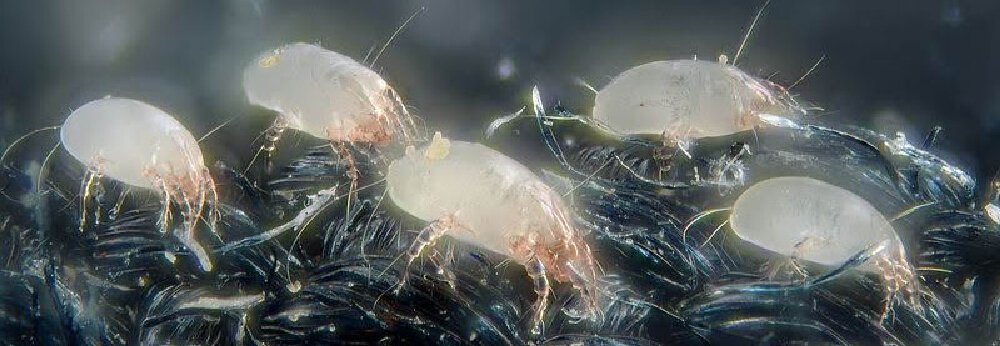Although it may be uncomfortable to think about, dust mites are a very normal part of our everyday lives. These microscopic creatures are nearly always present and often call soft surfaces (like mattresses, couches, and carpeting) within our living spaces “home.” There are also plenty of misconceptions and myths about dust mites, however much of this is simply hysteria that stems from the fact that bugs of any kind tend to make people squeamish.

It may be disconcerting to consider the fact that these bug-like organisms are crawling around within our homes, they should not be considered a danger. While there are steps that can be taken to minimize their effect on our environments, these tiny creatures are not as worrisome as many people would have you believe.
Read on to learn more about dust mites, their purpose, and what (if any) danger they pose to you and your loved ones.

Overview
Dust mites are microscopic beings that are completely invisible to the naked eye. Measuring only 0.2mm in size, they are an inevitability in our daily lives. They feast on dead skin or pet dander, meaning that they find our homes quite hospitable. It is a common misconception that only “dirty” homes contain Dust Mites. The truth is, nearly every home, no matter its level of cleanliness, hosts these tiny organisms.
While not dangerous, their secretions are released into the air where they are often mixed with other allergens. They also, unfortunately, reduce the amount of moisture within the air. While steps can be taken to reduce their impact and presence within your home, no one should lose sleep over totally ridding their home of dust mites.
Habitat
Like nearly all, dust mites require certain environmental factors to survive. They not only need a food supply, but they also need a warm and humid environment to live and reproduce. Many people incorrectly assume that they live on human skin.
Instead, they prefer soft, warm places that come in contact with human skin. Mattresses are a very popular habitat for dust mites, but clothing, pillows, and sofas also prove to be hospitable environments for dust mites to thrive.

Appearance
Any “photos” you see of dust mites are taken at extreme levels of magnification. Dust mites are invisible to the naked eye and can only be seen under a specialized electronic microscope. With that said, they belong to the same class as the common spider.
Rather than typical insects, which are categorized by their three body segments and six legs, Dust Mites have two body segments and eight legs. They are a creamy white color, and their body is a round shape. Their mouths and legs also come to a point, making them look like sinister little beings.
While their appearance is discomforting and alarming, it is important to note that dust mites are much more harmless than they appear in magnified images. They do not have eyes, wings, or antennae, and cannot jump or fly.
In fact, they communicate with other mites only through the secretion of chemicals and hormones. They may seem terrifying up close, but in reality, they are merely microscopic organisms that rarely make an impact on our daily lives.
Bites and Allergies
Because of their resemblance to “bugs,” dust mites are often blamed for unidentified bites or scratches that occur on our bodies. Fortunately, this blame is misplaced as dust mites are generally innocuous beings.
Many people incorrectly consider them to be similar to bed bugs or chiggers, which live in soft areas and cause irritating and uncomfortable bites on the skin. This simply is not true, as Dust Mites do not have the ability to bite a human under any circumstances.

With that said, dust mites can cause mild skin irritation on some individuals. Any irritation that they leave behind, however, is not due to bites. Rather, their secretions can contain certain enzymes that can cause skin reactions that lead to redness, bumps, or other rash-like areas. Additionally, their droppings can contain certain allergens that can lead to a skin rash or atopic dermatitis.
More commonly, Dust Mites cause allergic reactions. Their feces and chemicals can go airborne and cause inflammation in nasal passages, which can lead to cold-like symptoms such as a runny nose, itchy eyes, and general congestion.
Asthma sufferers are especially susceptible to issues with Dust Mites. They can cause an increase in asthma symptoms and, in rare cases, lead to extreme chest congestion and shortness of breath. If you notice that your asthma symptoms have become more severe and persistent, talking to a doctor will help you determine if Dust Mite allergies are the root cause of your respiratory issues.

Prevention
While dust mites can never be completely removed from your home, there are certain steps you can take to decrease their impact on your life. While they exist in any household environment, taking steps to keep your home clean will help reduce the number present within your living spaces.
Experts recommend allergen-resistant pillowcases as well as dust-proof covers for your mattress and box spring to deter them from living on your bed. Also, washing your bedding weekly in water that reaches 130°F will minimize the number present in your bedroom.
In addition, cleaning your home with a high efficiency purifying air (or HEPA) filter is key to keeping them out of your main living spaces. So too is removing soft surfaces like cloth curtains and replacing them with plastic or wooden blinds. Because they thrive on dust, regular dusting and immediately emptying vacuum dustbins is key to maintaining a healthier environment.

Conclusion
Dust mites are a small and unavoidable part of everyone’s life. Undetectable to the naked eye, they live on our bedding and furniture but are impossible to notice. While they do not bite like other unwanted household pests, they can cause allergic reactions, and their presence can worsen the symptoms of allergy and asthmas sufferers.
While steps can be taken to reduce their quantity and impact, they peacefully coexist with humans every single day.
If you have any questions or comments, please add them below in the comment section. Similarly, please let us know if you spot any mistakes or omissions. Thanks!
